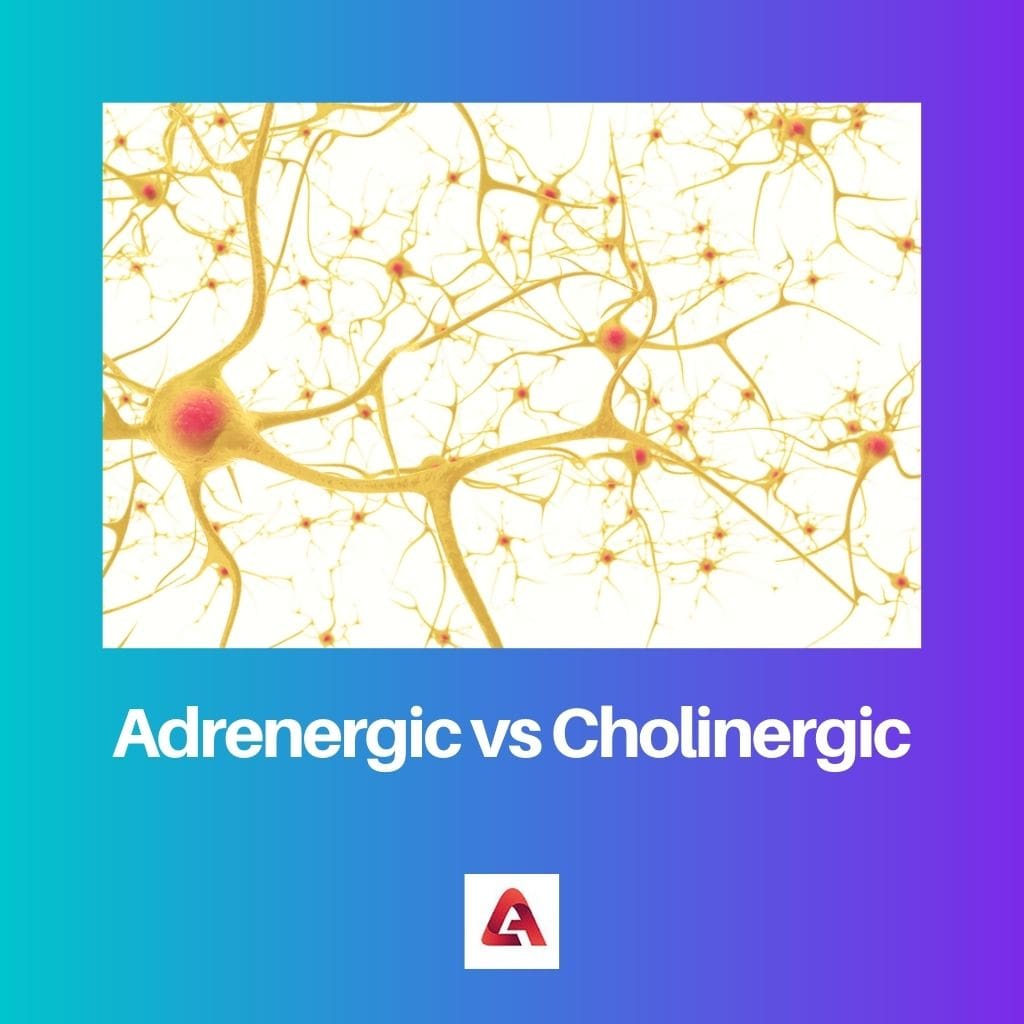Adrenergic and cholinergic are two pathways of the autonomous nervous system of our body that controls all the involuntary work of the body. Their differences are part of the body’s balancing system.
Key Takeaways
- Adrenergic receptors respond to neurotransmitters like adrenaline and noradrenaline, playing a role in the fight-or-flight response.
- Cholinergic receptors respond to the neurotransmitter acetylcholine, which is involved in various physiological processes, including muscle contraction and memory formation.
- Both adrenergic and cholinergic receptors are essential for the proper functioning of the nervous system, but they have distinct roles and effects on the body.
Adrenergic vs Cholinergic
Adrenergic receptors are activated by the neurotransmitter norepinephrine and epinephrine, regulating physiological responses to stress. Cholinergic receptors are activated by acetylcholine and are involved in the parasympathetic nervous system and neuromuscular junction, regulating rest and digestion.

Another key difference is that the adrenergic pathway is associated with Sympathetic Nervous System, while the cholinergic pathway is associated with the parasympathetic pathway.
Furthermore, the sympathetic nervous system related to the adrenergic pathway stimulates the heart by increasing its activity, while parasympathetic nerves related to the cholinergic pathway down-regulate the heart’s activity.
There are two types of adrenergic nerve receptors: alpha and beta, while cholinergic nerve receptors are of two types, nicotinic and muscarinic.
Adrenergic receptors are G-protein-bound receptors, while cholinergic receptors are inotropic and metabotropic.
The adrenergic pathway is responsible for the fight or flight response by releasing the catecholamines adrenalin from the adrenal gland. In contrast, the cholinergic pathway controls the digestion and rest response.
Comparison Table
| Parameter of Comparison | Adrenergic | Cholinergic |
|---|---|---|
| Part of which is the Nervous System | Sympathetic Nervous System | Parasympathetic Nervous System |
| Associated Neurotransmitter | Adrenaline and noradrenaline | Acetylcholine |
| Effect on heart | Stimulates faster activity | Downregulates activity |
| Types | Alpha and Beta | Nicotinic and muscarinic |
| Working of Receptor | G-protein coupled receptor | Intropic-ligand-gated and metabotropic receptors |
What is Adrenergic?
Adrenergic nerves are a part of the Sympathetic nervous system that houses the adrenergic receptors. These are G-protein coupled receptors that bind with several catecholamines that are released from the adrenal gland.
The two main neurotransmitters associated with adrenergic receptor binding are epinephrine or adrenaline and norepinephrine or noradrenaline. These are also responsible for the body’s fight-or-flight response.
When the sympathetic nerve endings in the heart bind with these neurotransmitters, they increase the heart’s activity by increasing heart rate, myocardial contractibility, and conduction velocity.
Apart from their effect on the heart, they also improve the temporary performance of the body by directing blood from unimportant organs to skeletal muscles. Other effects include dilation of pupils, increased blood pressure, expanding the lung cavity, etc.
Adrenergic receptors are of two type’s alpha and beta, which are further divided based on their function and effect on the body. When it binds to these receptors, Adrenaline causes vasoconstriction with alpha and vasodilation with beta receptors.

What is Cholinergic?
The cholinergic pathway is related to the parasympathetic nervous system that involves the functions of cholinergic receptors. These receptors are regarded as inotropic and metabotropic and are activated by the neurotransmitter Acetylcholine (ACh).
Acetylcholine neurotransmitters bind to the muscarinic and nicotinic receptors, the two main cholinergic receptors, to perform their functions. The cholinergic system drives the digestion and rest response of the body.
The vagus, or the parasympathetic nervous ending in the heart, is responsible for its cholinergic effects on it. When Acetylcholine binds to these receptors in the heart, they are responsible for down-regulating the heart’s functions.
This effect of lowering heartbeat and blood pressure by acetylcholine binding is a balancing act of the body. Other effects of acetylcholine include dilating blood vessels, increasing bodily secretions and smooth muscle contraction.
These receptors are found all over the body but mainly in the target organs such as sensory glands, respiratory tracts, heart, eyes, and gastrointestinal tract. They are also found in the somatic efferent nerves in the skeletal muscles.
Cholinergic receptors are part of the Somatic and Autonomic nervous systems and are divided into Nicotinic and Muscarinic receptors. Nicotinic receptors bind to nicotine, and muscarinic receptors bind to the muscarine.

Main Differences Between Adrenergic and Cholinergic
- The main difference between adrenergic and cholinergic is that adrenergic involves adrenaline and noradrenalin, whereas cholinergic involves using the neurotransmitter Acetylcholine.
- Another key difference is that adrenergic receptors are present in the sympathetic nervous system, while cholinergic receptors are in the parasympathetic nervous system.
- Adrenergic receptor binding induces improved heart activity and overall body performance, while cholinergic receptor binding down-regulates this effect.
- Adrenergic receptors are of two types, i.e. alpha and beta receptors, while the two types of cholinergic receptors are nicotinic and muscarinic receptors.
- Adrenergic receptor works by G-protein coupling while Cholinergic are intropic-ligand gated and metabotropic receptors.
- https://journals.physiology.org/doi/abs/10.1152/ajplegacy.1962.202.5.872
- https://science.sciencemag.org/content/132/3422/301.abstract

The comprehensive comparison of adrenergic and cholinergic pathways in the post provides an intellectually stimulating read, offering a wealth of knowledge on the topic.
I couldn’t agree more. The post’s in-depth analysis and comparison of the two pathways offer valuable insights into the body’s neurological mechanisms.
The detailed comparison between adrenergic and cholinergic pathways is enlightening. The post provides a thorough understanding of the topic.
I found the breakdown of cholinergic and adrenergic receptors very educational and easy to understand in this post.
I was looking for a detailed explanation of adrenergic and cholinergic receptors, and this post delivered exactly that. Great work!
This article is extremely helpful for anyone looking to understand the difference between the adrenergic and cholinergic pathways. It’s very well-written and informative.
Absolutely. The breakdown of the functions of adrenergic and cholinergic receptors is excellent in this post.
This post offers a highly informative and detailed comparison of adrenergic and cholinergic pathways, contributing to a deeper understanding of their roles in the body.
I completely agree. The post is an exceptional resource for gaining knowledge about the functions and effects of adrenergic and cholinergic receptors.
The thorough explanation of adrenergic and cholinergic pathways in the post presents complex information in a clear and understandable manner. Great content!
The comparison table in the post provides a clear and concise overview of the differences between adrenergic and cholinergic pathways. It’s highly informative.
I couldn’t agree more. The table makes it easy to understand the distinctions between the two pathways.
The post presents a very detailed analysis of adrenergic and cholinergic receptors, making it an excellent resource for anyone seeking information on the topic.
The post effectively highlights the key differences between adrenergic and cholinergic receptors, providing valuable knowledge on the topic.
I found the post to be an insightful resource for understanding the distinct roles and effects of adrenergic and cholinergic pathways. Great content!
The post thoroughly explains the differences between adrenergic and cholinergic receptors, offering a well-structured and educational read.
I agree. The content is both informative and engaging, making it an excellent reference for learning about these physiological pathways.
The post is very informative, it clearly explains the differences between adrenergic and cholinergic pathways and their effects on the body.
I couldn’t agree more. The post provides a clear and comprehensive comparison of the two pathways.
The clear and precise comparison of adrenergic and cholinergic pathways in the post makes for an insightful and educational read. Well done!
I found the breakdown of adrenergic and cholinergic receptors to be highly educational and beneficial. It’s a commendable piece of work.
The post effectively delves into the details of adrenergic and cholinergic pathways, making it a valuable resource for understanding their distinct functions.
The detailed insights into the adrenergic and cholinergic pathways make this post a valuable resource for understanding the nuances of the body’s autonomous nervous system.
The comparison between adrenergic and cholinergic pathways provides a captivating and educational read. Well done!
Absolutely. The post’s in-depth analysis of the two pathways provides a comprehensive understanding of their distinct roles in physiological processes.